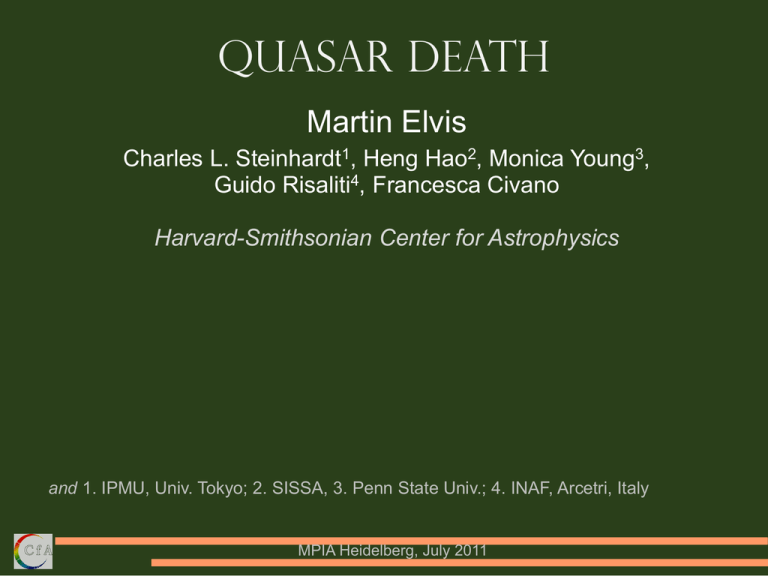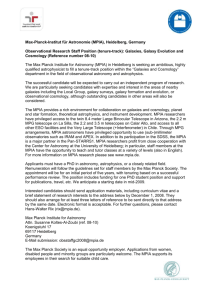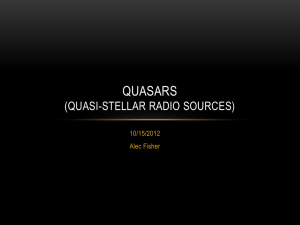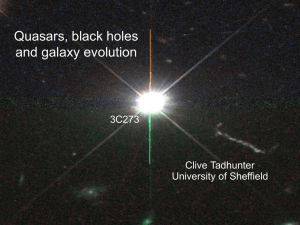
Quasar Death
Martin Elvis
Charles L. Steinhardt1, Heng Hao2, Monica Young3,
Guido Risaliti4, Francesca Civano
Harvard-Smithsonian Center for Astrophysics
and 1. IPMU, Univ. Tokyo; 2. SISSA, 3. Penn State Univ.; 4. INAF, Arcetri, Italy
MPIA Heidelberg, July 2011
Why Study Quasars?
Astronomy:
100,000 quasars
in the ROSAT
X-ray sky
Astrophysics:
Gravity powered
Not fusion.
Cosmology:
Co-evolution of
galaxies and
supermassive black holes
Relativistic jets
Physics:
Reynolds C.
Light bending near the
Event horizon
MPIA Heidelberg, July 2011
The 7 Ages of Supermassive Black Holes
1. Birth
Ignorant
2. Rapid growth – by z=7
No data
3. Merger growth
Know a little
4. Quasar growth – Soltan
Think we know quite a bit
5. Radio Mode
Know a little
6. Quasar Death - turn-off
Ignorant
7. Quiescence
Know a little
MPIA Heidelberg, July 2011
The Quasar Standard Model
MPIA Heidelberg, July 2011
The Quasar Standard Model
massive black hole
Lynden-Bell 1969
accretion disk
Lynden-Bell 1969, Pringle & Rees 1972,
Shakura & Sunyaev 1972
relativistic jet
Rees 1967 [PhD],
Blandford & Rees 1974
MPIA Heidelberg, July 2011
The quasar Spectral Energy Distribution (SED)
Elvis et al. 1994 ApJS, 95., 1 ( 1001 citations on 10 Dec 2010 )
Temperature: accretion disk
Radio
1 dex
IR
Opt/UV EUV
X-ray
Luminosity: Massive Black Hole
Elvis et al. 1994 mean SED works in 90%aof
Quasars
ox
(Hao et al. 2011, Harvard PhD 2011)
Quasar Growth physics is invariant with z, L, L/LEdd
Relativisitic Jet:
synchrotron
19
MPIA Heidelberg, July 2011
6
The quasar Standard Model
massive black hole
Lynden-Bell 1969
accretion disk
Lynden-Bell 1969, Pringle & Rees 1972,
Shakura & Sunyaev 1972
relativistic jet
No prediction of:
Atomic Features
Maximally Hot dust
X-rays
Evolution
Rees 1967 [PhD],
Blandford & Rees 1974
MPIA Heidelberg, July 2011
Age 4: Quasar Growth
MPIA Heidelberg, July 2011
Luminosity Function Evolution
Traditional approach
SDSS Richards et al. (2006)
MPIA Heidelberg, July 2011
Quasar Black Hole Masses
v2r=
r=const
GM
Keplerian
R=L1/2
1
Lag (days)
R
(cm)
1
2
Black
Hole
Mass
From a single spectrum
v2r
Vestergaard, 2002 ApJ 571,733
R( rg )
2
FWHM
Peterson & Wandel 1999
Peterson et al. 1993, PASP, 105, 247;
2006MmSAI..77..581P
MPIA Heidelberg, July 2011
Black Hole Mass Function vs. Redshift
z=2.8
Downsizing Age=2.3Gyr
z=1.25
Age=4.9Gyr
High Mass
Black Holes
Turn off
Vestergaard et al. (2008)
MPIA Heidelberg, July 2011
The Quasar Mass-Luminosity Plane
Luminosity
Charles Steinhardt, Harvard PhD Thesis 2010
SDSS DR5, all z
Kollmeier et al. 2006
Mas
Steinhardt
s & Elvis 2010
MPIA Heidelberg, July 2011
One M-L slice in redshift
0.2 < z < 0.4, H
Luminosity
SDSS Saturation
Detection Limit
Mass
MPIA Heidelberg, July 2011
Steinhardt &
Elvis 2010
MNRAS, 402,
2637
More physics than just Ledd
Longer BH growth times
Harder ‘Rapid Growth’ problem
0.2 < z < 0.4, H
Luminosity
One long ‘on-phase’ allowed?
Not episodic outbursts?
~0.5dex
Detection Limit
MPIA Heidelberg, July 2011
Mas
s
Steinhardt &
Elvis 2010
MNRAS, 402,
2637
Supermassive Black Holes Know about Cosmic Time
Boundary moves to higher mass at higher redshift
Low z
Not just accretion disk physics
High z
MPIA Heidelberg, July 2011
Steinhardt &
Elvis 2010
MNRAS, 402,
2637
Whole Population affected
L/LEdd distribution vs. Mass
Vertical cuts in M-L plane
High
mass
Low
mass
Left side of
each curve
is incomplete
Normalized to peak
MPIA Heidelberg, July 2011
0.2<z<0.4
Narrow L/Ledd Distribution at fixed redshift, Mass
• Common form
Normalized to peak
• Narrow L/LEdd range
• Comparable to variability
Intrinsic range is small
= Characteristic L//lEdd at each (M,z)
~0.3 dex
Are Quasars “Standard candles” after all?
Incomplete
MPIA Heidelberg, July 2011
More Complex Quasar Growth phase
Not all quasars can radiate at the Eddington limit
SMBH knows about cosmic time
Boundaries move with z
Quasars may not be episodic
Highest mass quasars at each z are sub-Eddington
Could have a single long on-phase
At each (z,M) there is a characteristic L/LEdd
“Standard Candles”?
MPIA Heidelberg, July 2011
Age 6: Quasar Death
MPIA Heidelberg, July 2011
Quasar Death: High mass SMBH don’t come back
Luminosity
Quasar Death line
Detection Limit
0.2 < z < 0.4, H
MPIA Heidelberg, July 2011
Mas
s
Death line moves to higher mass with redshift
Quasar Death line
• In each redshift bin, the highest mass quasars “die” by
the next Dz=0.2 bin
• Co-ordinated demise: Quasars know about cosmic time
1 Gyr
MPIA Heidelberg, July 2011
decline rate of number density depends on mass
Log M (solar)
9.75-10.0
Low
Mass
low
M
9.50-9.75
9.25-9.50
9.00-9.25
high High
M
Mass
Steinhardt & Elvis, 2011MNRAS.410..201S
MPIA Heidelberg, July 2011
A rapid demise
t Gyr
-t/t(M)
= N0eMasses
• Coordinated to <0.7Gyr @ N(t)
highest
• Set up at z>~10? (Age < 0.5 Gyr)
• Declines faster than galaxy mergers?
1 Gyr
9.0
log M/Msol
10
Steinhardt & Elvis, 2011MNRAS.410..201S
MPIA Heidelberg, July 2011
Brief High z Star Formation In Massive Galaxies
FWHM~100Myr
Thomas et al., 2010, MNRAS, 404, 1775
MPIA Heidelberg, July 2011
The Quasar ‘Dying Zone’
Luminosity
Quasar Death line
Detection Limit
0.2 < z < 0.4, H
MPIA Heidelberg, July 2011
Mas
s
Intrinsically red quasars lie in dying zone
Monica Young, Boston University PhD Thesis 2010
z = 1-1.2
z = 1.2-1.4
• 5/7 Red Quasars lie in “turn-off” region
z = 1.8-2.0
Young, Steinhardt et al. 2011, in prep.
MPIA Heidelberg, July 2011
Red Quasar Fraction
Dying (red) Quasars common at highest masses
1.5 < z < 1.7
d(g - i) > 0.3
35%
L<0.1LEdd
25%
Mas
s
Young, Steinhardt et al. 2010, in prep.
MPIA Heidelberg, July 2011
Quasars die first in UV
Strong CIV
logM 8.0
Weak CIV
zz==1.2-1.4
1-1.2
Larger MgII/CIV
at high masses
9.5
Weaker/softer ionizing continuum?
9.0
z~2
Steinhardt & Elvis,
2011MNRAS.410..201S
MPIA Heidelberg, July 2011
Low accretion rates in the dying zone
Monica Young, Boston University PhD Thesis 2010
Model NOT fit (only normalized)
Low mdot low disk temperature
T α (MBH.mdot) -1/4
Typical quasar
How are emission lines powered?
(Elvis+94)
Toy model
Young, Risaliti & Elvis 2008, ApJ, 688, 128
+ Young, et al., in prep.
MPIA Heidelberg, July 2011
First Clues to Quasar Death
Highest mass quasars at each z fail to reach
Eddington limit
Quasars die off rapidly above a critical mass at
each z
Death line moves down in mass toward present
Starving the accretion disk may fit ‘dying quasars’
MPIA Heidelberg, July 2011
Age 2: Early Rapid Growth
MPIA Heidelberg, July 2011
Evolutionary Tracks for Individual Quasars
Initial
Mass
Steinhardt, Elvis & Amarie, 2011 MNRAS in press, astro-ph/1103.4608
MPIA Heidelberg, July 2011
Tightly Constrained tracks
D 20%
M0
0.5 dex
t0
Mass
Luminosity
D 20%
k
a
Time
Mass
k = L/mdot = e/lifetime
Steinhardt, Elvis & Amarie, 2011 MNRAS in press, astro-ph/1103.4608
MPIA Heidelberg, July 2011
A Single Track for all SMBH?
k = L/mdot = e/lifetime
•k small: non-luminous growth dominates, but anti-Soltan
•k large: slow growth, smaller turn-off masses
Steinhardt, Elvis & Amarie, 2011 MNRAS in press, astro-ph/1103.4608
MPIA Heidelberg, July 2011
A single track for ALL Quasars ?
Invert
MgII masses only
to
give
z>0.8,
t0 < SMBH
6 Gyr
Initial Mass Function?
No exponential solutions
•: >0.2dex
from boundary
• Interpolation
issues
Steinhardt, Elvis & Amarie, 2010 MNRAS in press, astro-ph/1103.4608
MPIA Heidelberg, July 2011
First Clues to Quasar Initial growth
Quasars must stay within M,L locus
Simple evolutionary tracks can achieve this
A single evolutionary track for all quasars is allowed
Invert to get SMBH IMF?
MPIA Heidelberg, July 2011
The 7 Ages of Supermassive Black Holes:
What have we learned?
1. Birth
Ignorant
2. Rapid growth
Initial
Mass Function?
No data
3. Merger growth
Know a little
4. Quasar growth
L
≠ Ledd
; knows
z; standard
candle?
Think
we
know quite
a bit
5. Radio Mode
Know a little
6. Quasar Death
Rapid,
Ignorantcoordinated; starvation?
7. Quiescence
Know a little
Quasar Mass-Luminosity Plane is a valuable tool
MPIA Heidelberg, July 2011
All the world's a stage, And all the men and women
merely players; They have their exits and their
entrances; And one man in his time plays many
parts, His acts being seven ages. At first the
infant, Mewling and puking in the nurse's arms; And
then the whining school-boy, with his satchel And
shining morning face, creeping like snail Unwillingly
to school. And then the lover, Sighing like furnace,
with a woeful ballad Made to his mistress' eyebrow.
Then a soldier, Full of strange oaths, and bearded like
the pard, Jealous in honour, sudden and quick in
quarrel, Seeking the bubble reputation Even in the
cannon's mouth. And then the justice, In fair round
belly with good capon lin'd, With eyes severe and
beard of formal cut, Full of wise saws and modern
instances; And so he plays his part. The sixth age
shifts Into the lean and slipper'd pantaloon, With
spectacles on nose and pouch on side; His youthful
hose, well sav'd, a world too wide For his shrunk
shank; and his big manly voice, Turning again toward
childish treble, pipes And whistles in his sound. Last
scene of all, That ends this strange eventful history, Is
second childishness and mere oblivion; Sans teeth,
sans eyes, sans taste, sans everything.
The Seven ages of man
MPIA Heidelberg, July 2011
Jaques;
As You Like It,
Act II, Scene VII, lines 139-166’
William Shakespeare
S. Harris
Postscript:
Accretion Disk Winds
MPIA Heidelberg, July 2011
Atomic Features in Quasar Spectra
None are predicted by the Quasar Standard Model
High ionization BELs
e.g. CIV, OVI
Low ionization BELs
e.g. MgII, H.
MPIA Heidelberg, July 2011
Radiation Driving Determines Quasar Structure
Elvis 2000ApJ...545...63E; Risaliti & Elvis, 2010, A&A 516, A 89
High
Ionization
Absorber
(failed)
electronscattering
wind
Warm
Absorber/
High ionization
BLR
Line-Driven
wind
Cold
Eclipsers/
Low
ionization
BLR
Failed
wind
MPIA Heidelberg, July 2011
Slow
Cold
Eclipsers
Dust-Driven
Wind
NLR
Bicones
Broad
Absorption
Lines
Accretion Disk Winds: the 4th Element
Explains ALL Emission & Absorption Lines
Explains: Broad, Narrow Absorption Lines, High Ionization
Emission Lines, hot dust
Still no prediction of:
massive black hole
X-rays
Lynden-Bell 1969
accretion disk
Evolution: The 7 Ages of BH
Lynden-Bell 1969, Pringle & Rees 1972,
Shakura & Sunyaev 1972
relativistic jet
Rees 1967 [PhD],
Blandford & Rees 1974
disk winds
Murray et al., 1995
Elvis 2000
Nenkova et al., 2008
MPIA Heidelberg, July 2011
PS2: Merger Growth
MPIA Heidelberg, July 2011
Merger Growth: Hot-Dust Poor QUASARS
Heng Hao, Harvard PhD Thesis 2011
Hao et al. 2010 ApJ
Low Covering Factor (0.06-0.3)
Missing inner ‘torus’
z<1.5
1.5<z<3
merger-related
cause:
4.9%±0.8%
15.9%±3%
E94
Timing suggests
• Disrupted ‘torus’?
0.3-0.6
• Outburst destroyed inner dust?
dex
• Merger ejected SMBH+disk+BLR,
not ‘torus’? (Komossa & Merritt 2006; Guedes
et al., 2010)
MPIA Heidelberg, July 2011
Merger Growth in action: a Recoiling Black Hole
Civano et al. 2010 ApJ
Chandra COSMOS source CID-42
[OIII]
N
z=0.359
E
H
H
Off-nuclear source
Is the “AGN”
Dv=1180km/s
2.5kpc
by Eli
Bressert
15”
MPIA Heidelberg, July 2011









